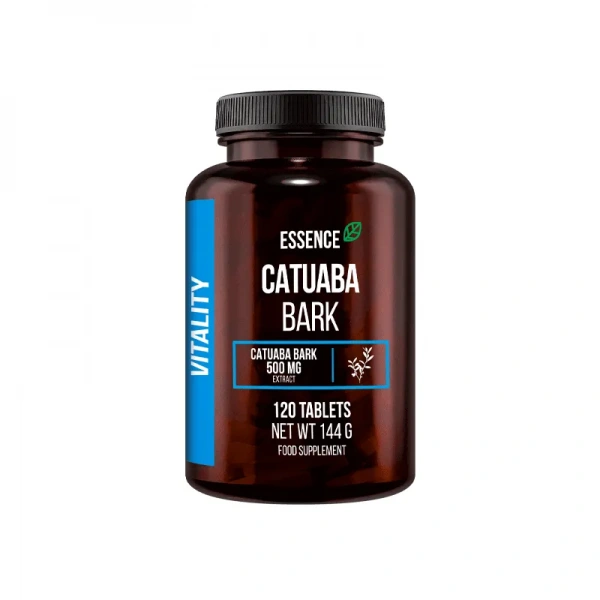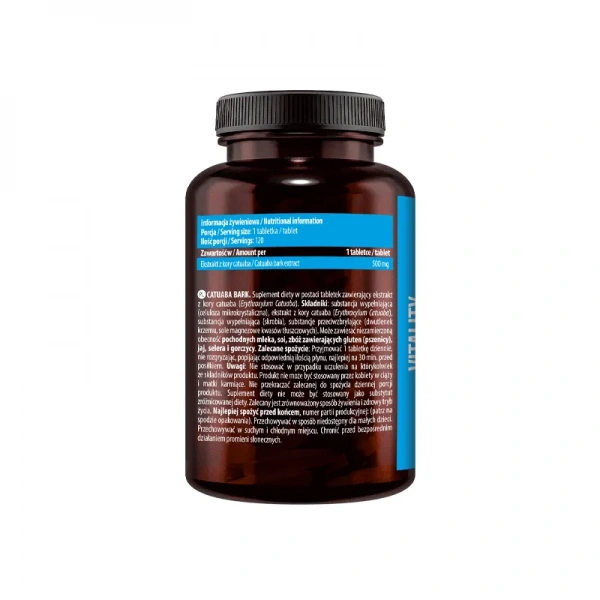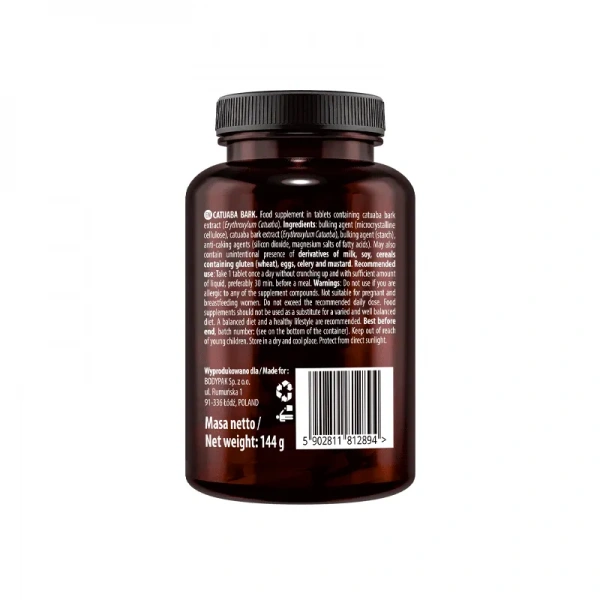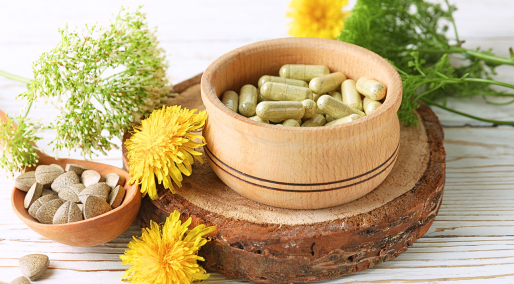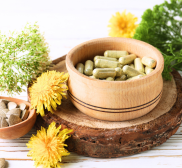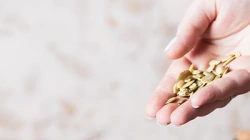Currency
- For the home
Health
- Bones and Joints
- Digestion and Healthy GI
- Essential Oils
- Fish Oil / Omega-3
- Healthy Sleep
- Heart and Cardiovascular System
- Immunity
- Liver
- MCT Oil
- Men
- Mind and Focus
- Minerals
- Pet Supplements
- Pro-Health Supplements
- Probiotics
- Senior
- Superfoods
- Urinary Tract
- Vitamins
- Vitamins for hair
- Vitamins for nails
- Vitamins for the skin
- Weight Management
- Woman
Healthy Diet
Herbs
Mother and Baby
Sport
Your Goal
Pet Supplements
Cosmetics
- Cosmetics for children
- Men's Cosmetics
- Unisex Cosmetics
- Women's Cosmetics
- Dezodoranty i perfumy
- Higiena jamy ustnej
- Kosmetyki akcesoria
- Kosmetyki dla dzieci2
- Kosmetyki do ciała
- Kosmetyki do higieny intymnej
- Kosmetyki do opalania
- Kosmetyki do pielęgnacji ust
- Kosmetyki do twarzy
- Kosmetyki do włosów
- Papier toaletowy / chusteczki
ESSENCE Catuaba Bark 500mg 120 Tablets
Available: 0 szt.
7,84 €
Price per portion: 0,07 €
Temporarily unavailable
Buy for 800 pts
After purchase you will receive 32 pts
You can exchange your accumulated loyalty points for this product. Log in to your account to check the number of available loyalty points.
After purchase you will receive 32 pts
After shipping your order, we will award you this amount of loyalty points. The loyalty program is available to customers who have an account in the store
Product Details
- Description
- Dosage
- Ingredients Table
- About the brand
- Nutritional information
- Reviews (0)
- Articles
The genus Erythroxylum consists of about 200 species, widely distributed in South America, Africa, and Madagascar. Erythroxylum is characterized by the presence of, among others. alkaloids, tannins, terpenes, flavonoids and phenylpropanoids.
Erythroxylum vacciniifolium is a popular flowering plant that comes from Brazil. An infusion made from this plant is traditionally called "catuaba" (a name also used for infusions of other types of plants). Catuaba is very widespread among the local population and is traditionally used. The active ingredient in catuaba is believed to be alkaloids called catuabins (alkaloids are organic compounds derived from plants that exhibit different biological activities). Catuaba owes its properties mainly to these compounds.
Catuaba and sexual functions
According to available scientific publications (Restrepo et al., 2019), indigenous peoples use Erythroxylum vacciniifolium leaves for their stimulant properties. In turn, the bark is used to support sexual functions. Catuaba is mainly known for its aphrodisiac properties. And did you know that "catuaba" is a tribal word meaning "what gives strength to an Indian."
Dosage
Consume 1 tablet a day, without chewing, with a sufficient amount of liquid, preferably 30 minutes. before meals.
Ingredients
Container: 120 TabletsServing Size: 1 Tablet
Servings per Container: 120
Form: Tablet
Ingredients
Content in a portion
in 100 g
% RDI
Catuaba bark extract
500mg
Other ingredients
Bulking agent (microcrystalline cellulose), catuaba bark extract (Erythroxylum Catuaba), bulking agent (starch), anti-caking agents (silicon dioxide, magnesium salts of fatty acids). The product may contain the unintended presence of milk derivatives, soybeans, gluten-containing grains (wheat), celery and mustard eggs.
About the brand
Nutritional information
A dietary supplement / A nutrition supplement as a substitute for everyday diet, used for weight control.
Cannot be used as a substitute of a healthy and balanced diet.
Not to be used by pregnant or nursing women.
Do not exceed recommended dosage per day.
Keep out of reach of children.
Best before: date on the package
All descriptions are the property of the www.mass-zone.eu. Copying or distribution is strictly prohibited! As per the Copyright Act from February 4th, 1994.
Manufacturer: 6 Pack Nutrition
Cannot be used as a substitute of a healthy and balanced diet.
Not to be used by pregnant or nursing women.
Do not exceed recommended dosage per day.
Keep out of reach of children.
Best before: date on the package
All descriptions are the property of the www.mass-zone.eu. Copying or distribution is strictly prohibited! As per the Copyright Act from February 4th, 1994.
Manufacturer: 6 Pack Nutrition
Reviews
No one has written a review for this product yet. Be the first to write a review.
there is no articles
Customers also bought
No data to display
OTHER PRODUCTS FROM THIS CATEGORY
Women's Support Formula With Wild Yam, Vitex, Dong Quai and GLA NOW Female…
18,85 €
Add to cart
MEDICA HERBS Red Clover 60 Capsules
Red clover (Trifolium pratense) supports the maintenance of a proper hormonal balance…
6,86 €
Add to cart
SWANSON Activated Charcoal (Regulates Digestion) 120 Capsules
Formulated to ease occasional gas and bloating Supports bowel regularity Maintains…
9,55 €
Add to cart
ForMeds Bicaps Red Clover 60 vegetable capsules
Dietary supplement BICAPS® RED CLOVER contains 24 mg of isoflavones from red clover…
14,20 €
Add to cart
SWANSON Chasteberry Fruit (Menstrual Pain Support) 120 Capsules
Chasteberry Fruit, also known as Vitex agnus- castus, has a long history of use…
9,06 €
Add to cart
Graviola ekstrakt (550 mg) 60 kapsułek - soul farm
"SKŁADNIKIgraviola ekstrakt 550 mg, kapsułka: pullulanOPISSuplement diety. Zawartość…
10,53 €
Add to cart
SWANSON Shatavari Root Extract 120 Capsules
A traditional Ayurvedic herb for the post- menopausal years Believed to help…
19,83 €
Add to cart
NOW FOODS D-Mannose (D-Mannoza) 85g
Urinary tract health support - D mannose is a naturally occurring simple sugar that…
18,36 €
Add to cart
ForMeds PRENACAPS Folate (Folic acid for pregnant women) 60 vegan capsules
PRENACAPS is a line of dietary supplements intended for women who are trying to…
18,61 €
Add to cart
Himalaya AyurSlim (Digestion, Metabolism) 60 Capsules
Ayurvedic slimming formula. Exttract Garcinia cambogia helps in weight control,…
10,04 €
Add to cart
NOW FOODS Chitosan Plus Chromium 500mg 240 Vegetarian Capsules
Super Fat Absorbing Action Supports Cholesterol Levels Already Within the Healthy…
41,87 €
Add to cart
SWANSON FemFlora (Female Bacterial Flora) 60 Capsules
Supports digestive, urinary and vaginal health. Supports overall women's health.…
12,24 €
Add to cart
LIFE EXTENSION Tri Sugar Shield 60 Vegetarian Capsules
Supports the balanced production of sugar in the liver Encourages a healthy…
36,73 €
Add to cart
SOLGAR Collagen Hyaluronic Acid 30 tablets
Hyaluronic Acid is a polymer made of repeating units of glucuronic acid and N-acetylglucosamine.…
32,32 €
Add to cart
ForMeds Bicaps Biotin (Healthy skin and hair) 60 vegetable capsules
Dietary supplement BICAPS® BIOTIN contains 2,500 μg of biotin in the form of D-biotin.…
8,81 €
Add to cart
NOW FOODS D-Mannose (D-Mannoza) 170g
Urinary tract health support - D mannose is a naturally occurring simple sugar that…
35,50 €
Add to cart
PiLeJe Feminabiane – Endo’Calm (endometriosis support, cycle regulation) 30 capsules + 60 tablets
Feminabiane Endo’Calm helps maintain the proper balance of the menstrual cycle,…
29,87 €
Add to cart
LIFE EXTENSION EsophaCool (Digestion, Esophageal Membrane Support) 60 Chewable Tablets
Provides fast-acting relief from digestive ailments Encourages a healthy inflammatory…
14,20 €
Add to cart
NOW FOODS Eve Superior Women's Multi 90 Tablets
HEALTH BENEFITS - NOW Foods Eve is one of the best products in the multivitamin…
25,95 €
Add to cart
INTENSON Vital Fiber - Seed Mix (Digestion Support) 1kg
A mixture of seeds with a high fiber content that supports the daily work of…
17,38 €
Add to cart
Newsletter
© 2023 mass-zone.eu. All rights reserved
Follow us
